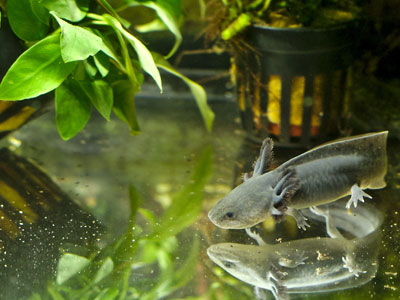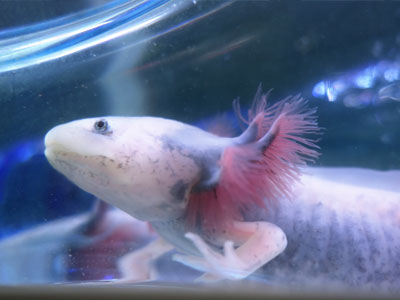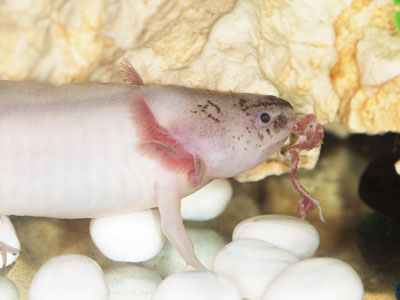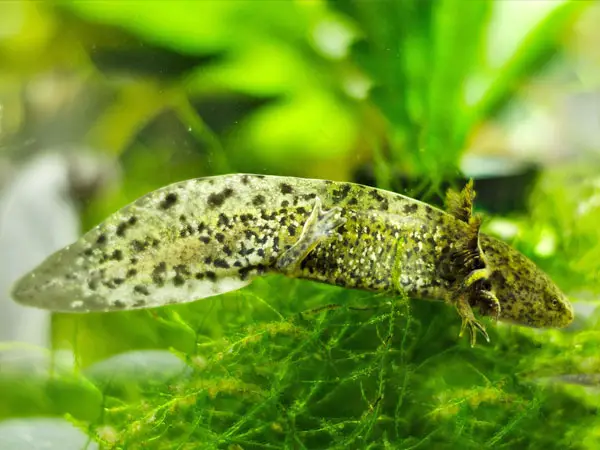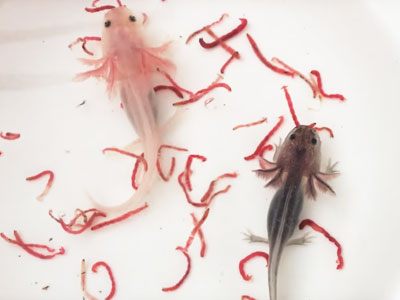
Baby axolotls have different feeding requirements compared to adult axolotls. For starters, they’re very small, so food that works for adult axolotls will not be a good choice for baby axolotls.
If you’re considering breeding and raising baby axolotls, it’s time to brush up on your axolotl nutrition knowledge, especially when it comes to feeding baby axolotls, whose dietary requirements are a bit different from their parents.
If you’re overwhelmed by the small size of these aquatic salamanders, don’t be. This guide to feeding axolotls will cover the basics and you’ll see that however small they may be, there are plenty of food options to match their mouths.
In this article I’m going to discuss the things you need to know about the feeding requirements of juvenile axolotls, the best foods for baby axolotls, how to feed baby axolotls, and how often should you feed baby axolotls.
What Do Baby Axolotls Eat?
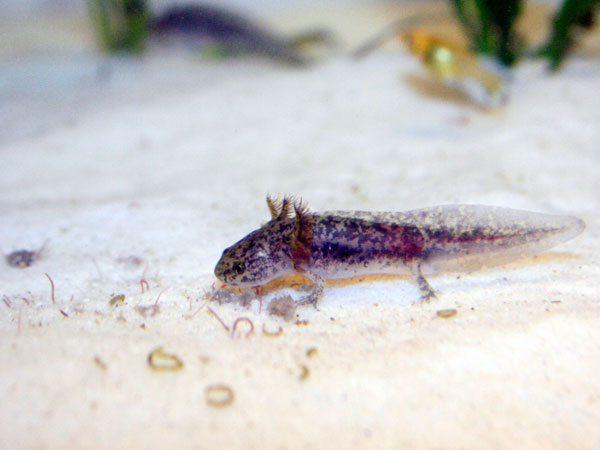
Before I get into the details on how and what to feed baby axies, I must mention that axolotls are carnivores and should be raised on a meat-based diet.
Newly hatched axolotls are too small to take on any food and won’t take on any food immediately after they hatch. Their size is at around 10-13 mm (roughly 0.5 inch).
In their larval stage, they still have some egg yolk that will provide them with sustenance for around 24-72 hours. While in this stage, they’re also motionless.
After the 24-72 hours period, baby axolotls are ready to eat and will quickly snap down on food you’re offering. But not just any food.
While adult axolotls can be fed with both living and nonliving foods, baby axolotls should be exclusively fed with live food.
The reason behind this is that unlike adult axolotls that have a strong sense of smell, baby axolotls have their sense of smell developed just yet. On the other hand, baby axolotls are great at spotting movement and thus, they can identify live food that wiggles.
Besides feeding them live food, you’ll also need to feed them small food, that is, food that can fit into their mouths.
Therefore, live cultured foods like daphnia, freshly hatched baby brine shrimp, microworms, chopped blackworms are all good options.
Let’s see what foods you should choose to feed to your axolotls:
Live Daphnia
Great for baby and juvenile axolotls alike, live daphnia is widely available in aquarium shops. However, you might want to create your own live culture or source live daphnia from fish-free cultures, because they can carry parasites and diseases that can be passed onto your axolotls.
They’re a cheap food source, nutritious, and suitable for baby axolotls. Even adult axolotls love them, but they’re not as nutritious for them.
You can set up your own cultures at home with the help of starter cultures and a special kit that you can order off Amazon.
Baby Brine Shrimp
Baby brine shrimp is another live food that you can culture at home and feed to baby axolotls. They’re highly nutritious and easier to culture than daphnia.
Brine shrimp is also a staple food for adult axolotls. The only downside of brine shrimp is that they’re a little messy, so you must be on top of your water changes and tank cleaning game.
Chopped Blackworms
Blackworms or white worms are most suitable for adult axolotls, although if you chop them up, you can feed them to juvenile axolotls too as they’ll still move a little even after being chopped up.
The downside of blackworms is that they’re very messy, so clean up any leftovers quickly and make sure you do water changes often to avoid water chemistry disbalances.
Microworms
Microworms are another good option for baby axolotls and you can easily create your own live cultures at home. With microworms, you don’t need to worry about size, although these too are messy, so be careful to clean your tank.
The Best Food for Baby Axolotls
Before I get into helping your decide which food is best for baby axolotls, it’s important to mention that not all axolotls develop at the same rate and separating baby axolotls based on size can be a good way to stimulate growth and make sure they develop properly.
It’s best to start separating them when they reach about 2 cm in length. At this size, they also display strong cannibalistic tendencies, which you don’t want to encourage.
Another important aspect in feeding baby axolotls is that they don’t all like the same foods. This is the reason why it’s difficult to determine which is the best food for baby axolotls from the ones I mentioned above.
Let’s say you’re only feeding them with live daphnia, which in of itself is a nutritious option that’s easily available, but not all your axies will enjoy it the same way.
This can cause delays in development, so it’s best if you try to feed them with a variety of live foods and include all or most of the live food options I described above.
As your axies grow and develop, they’ll be able to take on other foods as well such as soft salmon pellets or other living or non-living foods such as earthworms.
As they develop their front legs, axolotls will become more mobile in the tank and will actively “hunt” for their food. Once this happens, you can try to mix things up in their diet and introduce them to soft pellet type food or frozen food like bloodworms.
While I can’t pinpoint a best food for baby axies, one thing is certain — live foods or a variety of live foods work best both for baby axolotls and adult axolotls.
A Note on Baby Axolotl Food Safety
A major disadvantage of live foods is that they can carry diseases if they’re sourced from the wild or from waters with fish.
While freeze-dried foods don’t carry diseases and work well for other aquarium pets, they don’t interest larval axolotls, so substituting with freeze-dried alternatives is a no-go.
Therefore, my recommendation is to set up your own cultures of microworms, daphnia and baby brine shrimp and alternate between these.
If you don’t have the time to create live cultures of your own, you can buy them from aquarium shops, but do make sure they come from controlled sources and fish-free waters.
I also mentioned that some of these live foods can create a lot of mess in the container or tank you’re raising your axolotls, so do make sure you’re cleaning up leftovers and monitoring the water chemistry.
How to Feed Baby Axolotls?
Larval axolotls are tiny, their foods are tiny, which may make it difficult to feed baby axolotls. Raising and feeding baby axolotls in a large tank is not a good idea.
Best if you work with smaller containers, where there is less room and less water, which helps baby axolotls find their food a lot faster than in a small tank.
Depending on the number of baby axolotls you’re raising, you’ll need a few containers, especially if you’ve separated them according to size.
When feeding, there are a few tools that come in handy, such as tweezers, turkey baster, q-tips (mircorworms), which you can use to handle live foods with ease.
You will notice that food that doesn’t wiggle or move, won’t get the attention of your axolotls. So, make sure that food is wiggling or making movement when you feed it to them, otherwise they may not notice the food you’re offering.
You may have heard that adult axolotls don’t require daily feedings and that 2-3 feedings a week is plenty for them. While this is true for adult axolotls, baby axolotls do require daily feedings.
How Often to Feed Baby Axolotls?
Baby axolotls should be fed once or twice per day. You want to make sure not to overfeed them and to clean leftover food right away because all live foods axolotls like are quite messy and will quickly foul the water.
Adult axolotls can go without food for quite a while (up to 3 weeks even), but baby axolotls can only last a few days without food, so it’s important to have multiple live cultures at home.
Because baby axolotls are still developing, their metabolism is faster than that of adult axolotls, which explains why they require more frequent feedings.
Conclusion
Axolotls thrive on live food, especially baby axolotls. If you’re raising more than one baby axolotl, you’ll need to diversify their meat-based diet to meet their personal preferences.
Non-living foods can be introduced once axolotls develop their front legs that allow them to better move around in the aquarium and search for their food.
Baby axolotls require daily feedings and it’s best to separate them based on their size, so you can help along their development much better.
I hope this guide will help you meet the nutritional needs of your baby axolotls and that you now have a better understanding of the types of foods baby axolotls best enjoy.

